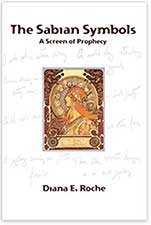I Ching, Yijing or Zhou Yi
"Oracle of the moon": © 2000 LiSe
 Yi Jing, Oracle of the Moon
Yi Jing, Oracle of the Moon


Sabian Symbols
The original symbols!
The book "The Sabian Symbols: A Screen of Prophecy" by Diana E Roche, with images of the original cards.
Dane Rudhyar adapted them to 'common sense', which is something you should not do with symbols. It narrows them down into descriptions and their metaphorical quality will be lost. It is like changing a dream to make it logical.
When I got to know the Yi better, I recognized a similarity between the astrological signs and the lines of the hexagrams. The bottom line is 'beginning' and 'action', just like Aries. The second line is the relation to others, like Gemini. And so on.
But the Yi had 384 lines, and the 12 signs had only 360 degrees. Or 365 days of the year. It looked very much alike - but not quite right. Then I realized that one could not combine a degree of the zodiac or a day of the year with a line of hex.1 or 2. No birthday could ever be pure yang or pure yin. But then there were still 2 hexagrams too much.
This means that hex. 63 and 64 are pure yang and pure yin too, but in this case young yang and young yin. Now I had 60 hexagrams left over - and 360 lines.
And then - which degree with every single line? I thought that the sequence of the Yi might not be random. Maybe it had begun its existence based on the moon-months. Each one 29 or 30 days, and always alternating yang and yin of the same element (or 'movement').
I decided to simply put the degrees and the lines together, both in their own sequence.
The Sabian Society has a beautiful website with material on Elsie Wheeler, Marc Edmund Jones, the Sabian Symbols, and a database with 30.000 nativities. And more.
Aries 1 goes together with hex.3 bottom line, Aries 2 with hex.4 bottom line, Aries 3 with hex.5 bottom line, and so on. Taurus 1 with hex.33 bottom line. And then Gemini 1 with hex.3 line 2, Gemini 2 with hex.4 line 2. The yang signs with the yang (odd) lines, the yin signs with the yin (even) lines.
Hex.62 talks about a bird which says to stay down. The image for the bottom line is a peacock parading on a lawn.
Hex.58 line 2 'sincere joyousness..'. The image: 'Contentment and happiness..'
5.5: Waiting at meat and drink. Image: two men playing chess. (Both about spending time in a pleasant way)
6.1: Not perpetuate an affair - Two lovers strolling.
6.4: Not engage in conflict - A group around a campfire.
7.1: The army should set forth in proper order - A triangle with wings.
8.3: Hold together with the wrong people - An old-fashioned woman and a flapper (something like a hippie)
8.6: He finds no head for holding together - A performer of a mystery play.
Just going through the first hexagrams. I used Wilhelm's translation, because almost everybody has it.
Another beauty: 48.1: One does not drink the mud of the well - An old man attempting vainly to reveal the mysteries.
And 48.6: One draws from the well without hindrance - The flow of inspiration.
BUT - no two different systems will match perfectly. Usually far from it. It doesn't mean they don't both come forth from the same universal patterns. They are too big for us to overview it, and besides, nature herself uses the same patterns and her children are all individuals. No two are identical, even if some come close.